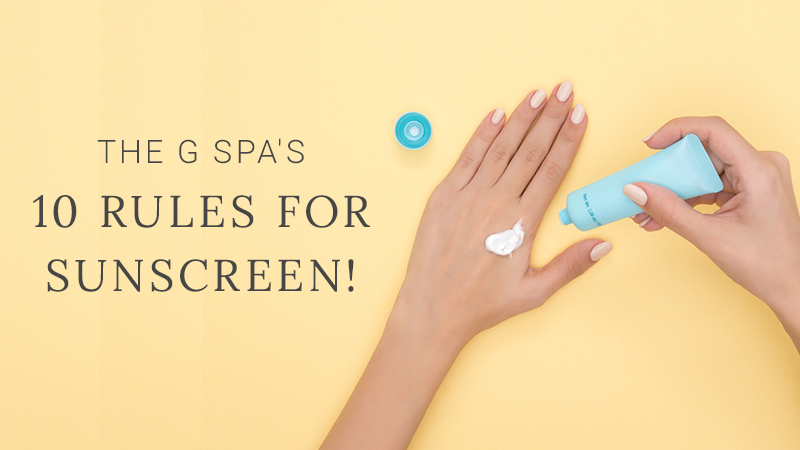The G Spa’s 10 Rules for Sunscreen!

It might be August already but here in Santa Barbara, California summer isn’t going anywhere. We love the abundance of sunshine but we can’t forget about the adverse effects of sun damage (e.g. sunburns, skin cancer, premature aging). Whether you’re spending a day at the beach, riding your bike along the coast, or wine tasting in the Funk Zone, remember to protect your skin.
Keep reading for our top rules about sunscreen.
- Sun protection = more than just sunscreen.
Don’t get us wrong—sunscreen is a great start. But take the next step in protecting your skin from the lasting effects of sun damage and remember that clothing can block UV exposure. So wear a wide-brimmed hat, sunglasses, and protective clothing whenever possible.
- Know what’s in your sunscreen.
Not sure what to look for? Sunscreens come in two forms: chemical (organic) and physical (inorganic). Chemical sunscreen ingredients, such as PABA, absorb UV rays and convert sun radiation into heat energy. Physical sunscreen ingredients, like zinc and titanium dioxide, deflect and scatter UVB, UVA1, and UVA2 rays before they penetrate your skin.
A note on environmental safety: Legislation was recently passed in Hawaii banning the sale of sunscreens that contain oxybenzone and/or octinoxate because they cause damage to the coral reefs and fish species. Because of this, The G Spa team is no longer going to be selling sunscreens that contain those chemicals.
- Look for a broad-spectrum product with zinc oxide.
A sunscreen label that says it’s “broad spectrum” will provide UVA protection. UVA makes up 95% of terrestrial UV radiation and penetrates the dermis, causing long-term damage. Unlike UVB, UVA isn’t filtered by clear glass and is constant throughout the day and all year. Zinc oxide provides a stronger UVA protection than other ingredients so double-check the label and beware of toxic chemicals such as parabens and oxybenzone.
- Use a lotion, cream or stick.
Sprays are convenient but they’ve been shown to leave spotty coverage. You may think you’re carefully coating your skin but it’s better to be safe than sorry so try switching to a lotion-type sunscreen!
- Don’t use products with Vitamin A.
Like we said in rule #3, beware of toxic chemicals. Some “natural” sunscreens still have harmful ingredients so read the labels and avoid those with vitamin A. Sunscreens and lip products that contain vitamin A (aka Retinyl Palmitate) have been shown to cause damage when exposed to the sun.
- Apply early.
You’ve probably heard the rule before: Always apply sunscreen at least 20 minutes before going outdoors. But are you following it? Sunscreen works best when applied 15-30 minutes before sun exposure, giving it time to absorb. Use about 1 ounce for your entire body (or a teaspoon to the face, neck, and each arm and two teaspoons to the torso and two to each leg) and then heed the next rule….
- It’s not “one and done.” It’s “apply, apply, apply again.”
Reapplying your sunscreen is crucial! Sunscreens lose their efficacy after too much time in the sun, time spent in water, or physical activities. So don’t forget: Apply and reapply often.
- Check the expiration date!
Sunscreens expire, believe it or not, and using them past their expiration date can leave your skin unprotected. If your bottle of sunscreen doesn’t have an expiration date, you can assume it loses its effectiveness after three years.
- Use sunscreen daily. It’s not just for summer!
Make putting on sunscreen a part of your daily morning routine. Many mineral-based sunscreens also include anti-aging moisturizers and other benefits beyond protecting your skin from harmful sun rays. What’s not to love?
- There’s no need to use anything higher than SPF 50.
Sun Protection Factor (SPF) is the ration of time it takes to develop a minimally detectable sunburn while wearing a sunscreen to the time it takes without sunscreen. The truth is, higher-SPF products don’t necessarily protect your skin better than lower-SPF ones do. According to the FDA, there is no evidence that any SPF higher than 50 actually offers more protection. It might just make you overconfident and less likely to reapply! At the minimum, you should be applying broad spectrum SPF 15 for protection against UVA and UVB rays. However, most people don’t put enough product on so dermatologists often recommend SPF 30 to be safe.
To recap, slather early and often! And read the bottles! Give us a call or stop by to see what products we recommend. You can also shop our online store for great skincare products.


